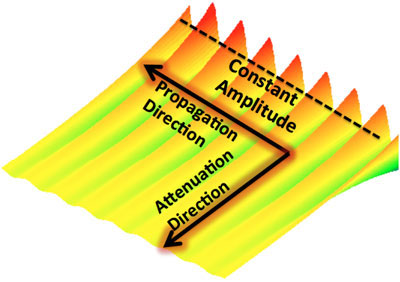| Posted: Sep 03, 2014 |
Inhomogeneous surface plasmon polaritons
|
|
(Nanowerk News) Researchers in the Center for Nanoscale Materials' Theory & Modeling and Nanophotonics groups at Argonne National Laboratory have discovered a new way to control light. Light can be guided along the surface of a metal via a surface plasmon polariton phenomenon. When light guided along the surface of one metal encounters a different metal surface, the new type of plasmon called an "inhomogeneous surface plasmon polariton" (ISPP) results that has controlled confinement properties ("Inhomogeneous Surface Plasmon Polaritons").
|
 |
| Field profiles of an ISPP illustrating one important property: the attenuation and propagation directions can be nearly orthogonal, introducing strong confinement of the optical energy.
|
|
ISPPs provide new ways to dynamically control the direction, speed, and confinement of optical energy and information flow at the nanoscale — key ingredients for new technologies for high-speed communications, optical storage, and advanced imaging techniques.
|
|
Analytical theory was developed to predict the existence of ISPPs, and high-performance computing facilities at CNM allowed rigorous numerical simulations to verify predictions. Experiments were designed to realize the predictions, including new fabrication techniques to make interfaced metal surfaces.
|
|
Analytical and rigorous computational electrodynamics calculations show how inhomogeneous surface plasmon polaritons can be generated by refraction of ordinary SPPs at metal-metal interfaces. ISPPs, in contrast with SPPs, propagate and decay in different directions and can therefore exhibit significantly different intensity patterns.
|
|
The analytical arguments are based on a complex generalization of Snell's law to describe how SPPs moving on one metal surface are refracted at an interface with a second, different metal surface. The refracted waveform on the second metal is an ISPP. Under suitable circumstances the decay of an ISPP can be almost perpendicular to the propagation direction, leading to significant confinement. ISPPs on the second metal also can retain information about the SPPs on the first metal, a phenomenon dubbed "dispersion imprinting."
|
|
The complex Snell's law predictions are validated with three-dimensional finite-difference time-domain simulations, and possible means of experimentally observing ISPPs are suggested. The idea of ISPPs and how they result from refraction may expand the potential for designing the propagation and dispersion features of surface waves in general, including surface phonon polaritons, surface magnons, and guided waves in metamaterials.
|

